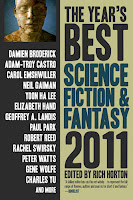I was browsing the Black Gate website the other day when I came across the post announcing that Matthew David Surridge's "The Word of Azrael" had been selected for inclusion in the forthcoming The Year's Best Science Fiction and Fantasy 2011 edited by Rich Horton. Congratulations to Mr. Surridge.
The thing that intrigued me, though, was when I followed the link to the table of contents and perused the titles, and more to the point, the sources of these stories. There are 28 titles listed, along with the venues in which they saw print. Or rather were published, with that term being defined to include electronic media. Of the selections Rich Horton chose as the best of the year (always a subjective list, as a perusal of the contents of the respective volumes in any given year will demonstrate), fifteen of them were published in electronic format in seven different venues: Apex, Clarke's World, Fantasy Magazine, Lightspeed, Strange Horizons, Subterranean, and Tor.com. Fantasy and Lightspeed each had four stories. Tor, Apex, and Clarke's World each had one.
Several anthologies were represented with single stories. Among the big three of the print magazines, F&SF and Asimov's each made the list with 3, while what is the magazine with by far the largest print circulation, Analog, didn't make the list at all. Neither did Realms of Fantasy, Interzone, Postscripts, or Weird Tales. I find this interesting, especially given the much publicized death and resurrection of RoF last month and the various comments about why it died posted several places on the web.
The ToC of Johnathan Strahan's The Best Science Fiction and Fantasy of the Year hasn't been released yet, even though it has a March release date, nor have the contents of the Dozois or Hartwell and Cramer volumes, which typically hit shelves in the summer (although this year's fantasy volume is still listed as forthcoming on Kathryn Cramer's blog). It will be very interesting to see where they chose their selections from, mostly print, mostly online, or about an even mix. It will also be interesting to see whether the heavy- and middle-weights that didn't make Horton's cut make fare much better in the other volumes.
There's no doubt we are seeing a major change in the publishing of short fantastic fiction. Not only are there more electronic periodicals out there than ever before, the print magazines may be seeing their first circulation increases in years thanks to Kindle, Nook, and other e-readers. I for one am not about to try to predict where the trends are heading, for one reason because things are changing so fast that by the time some trends become evident, they've mutated into something else. I will keep as much of an eye on things as I can, and you can bet I will write about them here.


Strahan already released his table of contents, the same day Horton did.
ReplyDeleteThank you. Why I didn't think to check his blog, I don't know. It was late when I wrote the post, I guess. I had checked the publisher's website, which didn't (and still doesn't) have the ToC posted. When I finish grading final exams in a couple of days, I'll go over go the list of Strahan's selections in detail. He didn't list his sources, and I don't have time right now to track them all down. I'm definitely curious to see the ratio of print venues to electronic ones. A project for later in the week.
ReplyDelete